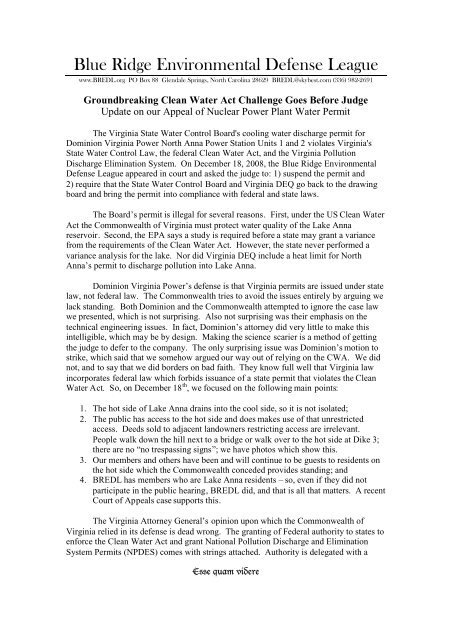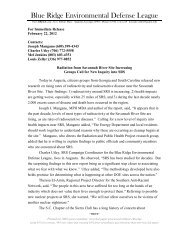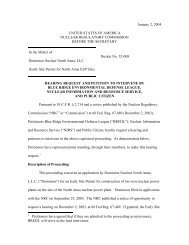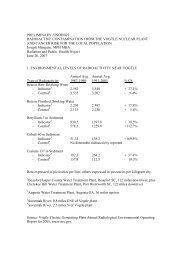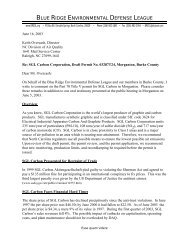North Anna Water Permit Background - Blue Ridge Environmental ...
North Anna Water Permit Background - Blue Ridge Environmental ...
North Anna Water Permit Background - Blue Ridge Environmental ...
Create successful ePaper yourself
Turn your PDF publications into a flip-book with our unique Google optimized e-Paper software.
<strong>Blue</strong> <strong>Ridge</strong> <strong>Environmental</strong> Defense League<br />
www.BREDL.org PO Box 88 Glendale Springs, <strong>North</strong> Carolina 28629 BREDL@skybest.com (336) 982-2691<br />
Groundbreaking Clean <strong>Water</strong> Act Challenge Goes Before Judge<br />
Update on our Appeal of Nuclear Power Plant <strong>Water</strong> <strong>Permit</strong><br />
The Virginia State <strong>Water</strong> Control Board's cooling water discharge permit for<br />
Dominion Virginia Power <strong>North</strong> <strong>Anna</strong> Power Station Units 1 and 2 violates Virginia's<br />
State <strong>Water</strong> Control Law, the federal Clean <strong>Water</strong> Act, and the Virginia Pollution<br />
Discharge Elimination System. On December 18, 2008, the <strong>Blue</strong> <strong>Ridge</strong> <strong>Environmental</strong><br />
Defense League appeared in court and asked the judge to: 1) suspend the permit and<br />
2) require that the State <strong>Water</strong> Control Board and Virginia DEQ go back to the drawing<br />
board and bring the permit into compliance with federal and state laws.<br />
The Board’s permit is illegal for several reasons. First, under the US Clean <strong>Water</strong><br />
Act the Commonwealth of Virginia must protect water quality of the Lake <strong>Anna</strong><br />
reservoir. Second, the EPA says a study is required before a state may grant a variance<br />
from the requirements of the Clean <strong>Water</strong> Act. However, the state never performed a<br />
variance analysis for the lake. Nor did Virginia DEQ include a heat limit for <strong>North</strong><br />
<strong>Anna</strong>’s permit to discharge pollution into Lake <strong>Anna</strong>.<br />
Dominion Virginia Power’s defense is that Virginia permits are issued under state<br />
law, not federal law. The Commonwealth tries to avoid the issues entirely by arguing we<br />
lack standing. Both Dominion and the Commonwealth attempted to ignore the case law<br />
we presented, which is not surprising. Also not surprising was their emphasis on the<br />
technical engineering issues. In fact, Dominion’s attorney did very little to make this<br />
intelligible, which may be by design. Making the science scarier is a method of getting<br />
the judge to defer to the company. The only surprising issue was Dominion’s motion to<br />
strike, which said that we somehow argued our way out of relying on the CWA. We did<br />
not, and to say that we did borders on bad faith. They know full well that Virginia law<br />
incorporates federal law which forbids issuance of a state permit that violates the Clean<br />
<strong>Water</strong> Act. So, on December 18 th , we focused on the following main points:<br />
1. The hot side of Lake <strong>Anna</strong> drains into the cool side, so it is not isolated;<br />
2. The public has access to the hot side and does makes use of that unrestricted<br />
access. Deeds sold to adjacent landowners restricting access are irrelevant.<br />
People walk down the hill next to a bridge or walk over to the hot side at Dike 3;<br />
there are no “no trespassing signs”; we have photos which show this.<br />
3. Our members and others have been and will continue to be guests to residents on<br />
the hot side which the Commonwealth conceded provides standing; and<br />
4. BREDL has members who are Lake <strong>Anna</strong> residents – so, even if they did not<br />
participate in the public hearing, BREDL did, and that is all that matters. A recent<br />
Court of Appeals case supports this.<br />
The Virginia Attorney General’s opinion upon which the Commonwealth of<br />
Virginia relied in its defense is dead wrong. The granting of Federal authority to states to<br />
enforce the Clean <strong>Water</strong> Act and grant National Pollution Discharge and Elimination<br />
System <strong>Permit</strong>s (NPDES) comes with strings attached. Authority is delegated with a<br />
Esse quam videre
Page 2 of 6<br />
<strong>Blue</strong> <strong>Ridge</strong> <strong>Environmental</strong> Defense League<br />
floor below which the state may not go. In its defense of the <strong>North</strong> <strong>Anna</strong> NPDES permit,<br />
Virginia claimed that its surface water regulations exclude certain waters—in this case<br />
the hot side of the lake. The Commonwealth makes state law but the state may not go<br />
below the floor established by federal law; they may only make regulations more<br />
stringent, not less.<br />
Contrary to what Dominion-Virginia Power says, it does not matter who created<br />
the lake. Lake <strong>Anna</strong> is “waters of the United States” governed by the Clean <strong>Water</strong> Act.<br />
It does not matter that the state has granted the permit many times before. Committing an<br />
error more than once does not justify the original error. It does not matter what lakeside<br />
residents’ deeds say. What matters is that Virginia is bound to enforce the minimum<br />
standards of the Clean <strong>Water</strong> Act. These standards include the limitation of pollution and<br />
heat is a pollutant under the Clean <strong>Water</strong> Act.<br />
Review of the Arguments Presented on December 18, 2008<br />
I. The Board Improperly Issued <strong>Permit</strong> No. VA0052451 Based Upon An<br />
Erroneous Determination That The “Hot Side” of Lake <strong>Anna</strong> Is Exempt<br />
From Regulation.<br />
Congress enacted the Clean <strong>Water</strong> Act to restore and maintain the chemical,<br />
physical, and biological integrity of the Nation’s waters by reducing, and eventually<br />
eliminating, the discharge of pollutants into these waters. 1 In the CWA, Congress<br />
established the National Pollution Discharge Elimination System (NPDES) program,<br />
which issues permits that allow the discharge of pollutants as long as they comply with<br />
standards set forth in the CWA. 2 The CWA allows states to operate their own programs<br />
under the NPDES, provided the states adhere to standards at least as stringent as the<br />
federal requirements. 3 Virginia has such a program – the Virginia Pollution Discharge<br />
Elimination System (VPDES), which was approved by the EPA Administrator in 1975. 4<br />
VPDES permits must contain limitations necessary to meet water quality standards<br />
developed by the state. 5 Once water quality standards have been set, permit limitations<br />
must be established to ensure compliance, regardless of the availability or effectiveness<br />
of treatment technologies. 6<br />
The Virginia State <strong>Water</strong> Control Board (Board) is charged with administering<br />
Virginia’s state VPDES program under the CWA’s NPDES program. 7 . Essentially, the<br />
Commonwealth of Virginia is running a Federal program – the NPDES – locally, and is<br />
not creating its own program. Accordingly, the Board must follow the CWA to ensure<br />
1 Natural Res. Def. Council, Inc. v. EPA, 16 F.3d 1395, 1399 (4th Cir. 1993) (citing 33 U.S.C. § 1251(a)).<br />
2 33 U.S.C. § 1342(a)(1) (2007)<br />
3 See 33 U.S.C. § 1342(b) & (c)(1) (2007); 40 C.F.R. § 122.1(a)(2) (2007); see also State <strong>Water</strong> Control<br />
Bd. v. Smithfield, 261 Va. 209, 212, 542 S.E.2d 766, 768 (2001).<br />
4 Id. at 212, 542 S.E.2d at 768; 40 Fed. Reg. 20,129 (May 8, 1975) (approving Virginia’s NPDES<br />
program).<br />
5 Id. (citing 33 U.S.C. 1313)<br />
6 Westvaco, 899 F.2d at 1384<br />
7 See Va. Code Ann. § 62.1-44.15 (2008)<br />
Esse quam videre
Page 3 of 6<br />
<strong>Blue</strong> <strong>Ridge</strong> <strong>Environmental</strong> Defense League<br />
that all VPDES permits measure up to the standards articulated by Congress in the CWA.<br />
The permit issued in this case represents an abject failure to uphold federal water<br />
quality standards. By refusing to limit heat discharge into the “hot side” of Lake <strong>Anna</strong>,<br />
the Board failed to regulate 3,400 acres of “waters of the United States” protected under<br />
the CWA.<br />
The CWA unequivocally prohibits the discharge of heat into waters of the United<br />
States except by permit issued by either the EPA or the states. The SWCB committed an<br />
error in determining that the “hot side” of Lake <strong>Anna</strong> did not fall within its regulatory<br />
jurisdiction. The CWA is a sweeping mandate. The CWA prohibits the discharge of any<br />
pollutant into “navigable waters” except in compliance with its provisions. 8 The CWA<br />
defines “navigable waters” as “waters of the United States” and classifies heat as a<br />
pollutant subject to regulation. 9 The VPDES program must comply with the mandates<br />
of the CWA. 10 In other words, the Board cannot allow any “waters of the United States”<br />
to go unregulated under the CWA. Congress intended that the term “waters of the United<br />
States” have the broadest possible interpretation. 11 According to the EPA and the Army<br />
Corps of Engineers, “waters of the United States” means: 12<br />
a) All waters which are currently used, were used in the past, or may be susceptible<br />
to use in interstate or foreign commerce, including all waters which are subject to<br />
the ebb and flow of the tide;<br />
b) All interstate waters, including interstate “wetlands;”<br />
c) All other waters such as intrastate lakes, rivers, streams (including intermittent<br />
streams), mudflats, sandflats, “wetlands,” sloughs, prairie potholes, wet meadows,<br />
playa lakes, or natural ponds the use, degradation, or destruction of which would<br />
affect or could affect interstate or foreign commerce including any such<br />
waters1) Which are or could be used by interstate or foreign travelers for<br />
recreational or other purposes; (2) From which fish or shellfish are or could be<br />
taken and sold in interstate or foreign commerce; or (3) Which are used or could<br />
be used for industrial purposes by industries in interstate commerce;<br />
d) All impoundments of waters otherwise defined as waters of the United States<br />
under this definition;<br />
e) Tributaries of waters identified in paragraphs (a) through (d) of this definition;<br />
f) The territorial sea; and<br />
g) “Wetlands” adjacent to waters (other than waters that are themselves wetlands)<br />
identified in paragraphs (a) through (f) of this definition.<br />
Cooling ponds which also meet these criteria are waters of the United States. 13<br />
Although “waste treatment systems” are excluded from the definition of “waters of the<br />
8 33 U.S.C. § 1311(a), 1362(12) (2007).<br />
9 Id. § 1362(6)-(7).<br />
10 See State <strong>Water</strong> Control Bd. v. Smithfield Foods, Inc., 261 Va. 209, 212, 216, 542 S.E.2d 766, 768, 770<br />
(2001) (quoting 40 C.F.R. § 122.1(a)(2)).<br />
11 Ohio Valley Envtl. Coal. v. U.S. Army Corps of Eng’rs, No. 3:05-0784, 2007 WL 2200686, at *11<br />
(S.D.W. Va. Jun. 13, 2007) (quoting S. Conf. Rep. No. 92-1236, at 144 (1972), as reprinted in 1972<br />
U.S.C.C.A.N. 3776, 3822).<br />
12 33 C.F.R. § 328.3(a) (2007); 40 C.F.R. § 122.2 (2008)<br />
13 as defined in 40 CFR 423.11(m)<br />
Esse quam videre
Page 4 of 6<br />
<strong>Blue</strong> <strong>Ridge</strong> <strong>Environmental</strong> Defense League<br />
United States,” cooling ponds do not enjoy this exclusion. 14 Interpretation of this<br />
regulation is a matter of law. 15 The hot side is not a waste treatment system, but rather a<br />
cooling lake. The Board improperly broadened the “waste treatment system” exception<br />
to exclude the hot side of Lake <strong>Anna</strong> from regulation.<br />
Congress stated that the use of rivers, lakes, streams, or the ocean as waste<br />
treatment systems was unacceptable. 16 The “hot side” of Lake <strong>Anna</strong>, which was<br />
created by the impoundment of the <strong>North</strong> <strong>Anna</strong> River and is fed by ten tributaries,<br />
cannot fall within the waste treatment system exclusion. The Board’s broad<br />
interpretation of the “waste treatment system” exclusion has been rejected by the courts<br />
that have addressed the issue.<br />
Despite the failure of the Commonwealth to require “cooling ponds” to be<br />
regulated under the VPDES, the Board committed a bigger error by glossing over the fact<br />
that the “hot side” is a cooling lake which is within EPA’s and the Board’s jurisdiction.<br />
The EPA stated why “cooling ponds” 17 and “cooling lakes” 18 must be regulated under the<br />
CWA. 19 Cooling ponds meet the criteria for “waters of the United States” if they are “. . .<br />
for example, those which are used for fishing or other recreational purposes by interstate<br />
travelers . . .” 20 And, cooling lakes are always “waters of the United States” 21 subject to<br />
regulation under the CWA and VPDES.<br />
The “hot side” of Lake <strong>Anna</strong> is a “cooling lake” subject to CWA and VPDES<br />
regulatory permitting. Lake <strong>Anna</strong> – both the “hot side” and “cool side” – was created by<br />
impounding the <strong>North</strong> <strong>Anna</strong> River, a “water of the United States.” Thus, it is an<br />
impoundment that impedes the flow of a navigable stream. <strong>Water</strong> from the “cool side” of<br />
Lake <strong>Anna</strong> flows through the <strong>North</strong> <strong>Anna</strong> Power Station to remove heat, and the heated<br />
water byproduct is subsequently released into the “hot side” of Lake <strong>Anna</strong>. <strong>Water</strong> then<br />
flows through the “hot side” until it is discharged back into the “cool side” at Outfall 001,<br />
when the process repeats. Since the “hot side” meets all elements of the definition of<br />
“cooling lake,” it must be so classified and regulated under the CWA and VPDES<br />
14 The referenced section that supposedly defines “cooling ponds” does not exist in the current Code of<br />
Federal Regulations. However, at the time the original definition of “waters of the United States” was<br />
promulgated, “cooling ponds” were defined as “any manmade water impoundment which does not impede<br />
the flow of a navigable stream and which is used to remove heat from condenser water . . . .” 40 C.F.R. §<br />
423.11(m) (1979).<br />
15 See Christensen v. Harris County, 529 U.S. 576, 588 (2000).<br />
16 Ohio Valley, 2007 WL 2200686, at *11 (quoting S. Rep. No. 92-414, at 7 (1971), as reprinted in 1971<br />
U.S.C.C.A.N. 3668, 3674.<br />
17 A cooling pond is defined as “any manmade water impoundment which does not impede the flow of a<br />
navigable stream” used to remove “heat from heated condenser water prior to returning the recirculated<br />
cooling water to the main condenser.” 40 C.F.R. 423.11(m) (1979).<br />
18 A “cooling lake” is defined as “any manmade water impoundment which impedes the flow of a<br />
navigable stream” used to remove “heat from heated condenser water prior to recirculating the water to the<br />
main condenser.” Id. § 423.11(n).<br />
19 See 44 Fed. Reg 32,854, 32,858 (Jun. 7, 1979)<br />
20 Id<br />
21 This term is used interchangeably with “navigable waters” throughout the CWA and its interpretive<br />
regulations.<br />
Esse quam videre
Page 5 of 6<br />
<strong>Blue</strong> <strong>Ridge</strong> <strong>Environmental</strong> Defense League<br />
program. By following the Virginia Attorney General’s erroneous interpretation, the<br />
Board failed to regulate 3,400 acres of waters of the United States protected under the<br />
CWA. Second, the “hot side” “harbors fish populations which invite recreational uses.<br />
There is a minimum of 13 public access areas for fishing on the “hot side” of Lake <strong>Anna</strong>.<br />
On its website, Dominion states that the “Lake <strong>Anna</strong> reservoir and the Waste Heat<br />
Treatment Facility have become a popular outdoor recreational area, whose shoreline is<br />
dotted with homes, cabins.” 22 Owners of properties that abut the “hot side” of Lake <strong>Anna</strong><br />
have deeds which demonstrate the Dominion contemplated such recreational uses. These<br />
deeds allow the owners to construct piers and other recreational or protective structures.<br />
The Board simply ignored these recreational uses during the most recent<br />
permitting. The Board failed to account for the fact that Dominion is not the only user<br />
of the “hot side” of Lake <strong>Anna</strong>. Rather, thousands of homeowners and recreational<br />
visitors use the “hot side” and must be protected under the CWA. Second, as discussed<br />
above, the “hot side” cannot be legally classified as a “treatment facility.” Dominion<br />
simply cannot be permitted to have it both ways. It cannot sell land and allow<br />
recreational uses on the “hot side” while simultaneously claiming that it is a “waste<br />
treatment” cesspool that is beyond regulation.<br />
Since the “hot side” is a “cooling lake” subject to CWA and VPDES jurisdiction,<br />
it was error to issue <strong>Permit</strong> No. VA0052451 without limits and regulation on thermal<br />
pollution discharges into the “hot side.”<br />
II.<br />
States must develop water quality standards pursuant to section 303 of<br />
the CWA. These standards consist of: (i) a designated “use” for the<br />
subject waters and (ii) “water quality criteria” specifying the maximum<br />
levels of various pollutants to comport with the designated uses. 23<br />
Under the Clean <strong>Water</strong> Act, the State <strong>Water</strong> Control Board sets Virginia’s <strong>Water</strong><br />
Quality Standards. 24 According to the Fourth Circuit Court of Appeals, “once water<br />
qualities have been set, NPDES permit limitations must be established to ensure<br />
compliance, regardless of the availability or effectiveness of treatment technologies.” 25<br />
Since the “hot side” of Lake <strong>Anna</strong> is a “water of the United States” subject to and<br />
requiring regulation under the CWA and VPDES program, it must meet standards for<br />
thermal pollution.<br />
According to the permit’s Fact Sheet, Lake <strong>Anna</strong> is part of the York River Basin<br />
and is designated a Class III water under Virginia’s water quality standards regulations.<br />
Under this classification, the upper limit on temperature is 32 degrees Celsius, or 89.6<br />
degrees Fahrenheit. 26 The data collected by Dominion and summarized by the Board<br />
unequivocally demonstrates that both hourly and mean temperatures in the “hot side” of<br />
22 http://www.dom.com/about/stations/nuclear/northanna/index.jsp (last visited Oct. 15, 2008)<br />
23 40 C.F.R. §§ 131.2-3 (2007).<br />
24 See 9 VAC 25-260-50, -60-90 (2007).<br />
25 Westvaco Corp. v. EPA, 899 F.2d 1383, 1384 (4th Cir. 1990) (emphasis added).<br />
26 9 VAC 25-260-50 (2007).<br />
Esse quam videre
Page 6 of 6<br />
<strong>Blue</strong> <strong>Ridge</strong> <strong>Environmental</strong> Defense League<br />
Lake <strong>Anna</strong> routinely exceed this 32-degree Celsius threshold from May through October.<br />
Dominion and the Board also concede that these temperature violations are due to the<br />
discharge of heat from the <strong>North</strong> <strong>Anna</strong> Power Station into the “hot side.” 27 Therefore,<br />
the “hot side” is in continued violation of the water quality standards and the CWA.<br />
Since it has not applied for the variance required by the CWA at the Outfall 101<br />
discharge point, the Board committed an error by issuing a permit that allows for<br />
continued derogation of the Commonwealth’s and the CWA’s water quality standards.<br />
Section 316(a) of the CWA allows owners of thermal-discharging point sources<br />
(i.e. the <strong>North</strong> <strong>Anna</strong> Power Station) to apply for a variance from any effluent limitation<br />
proposed for the control of the thermal component of any discharge if it is shown that the<br />
current effluent limitation is more stringent than necessary to assure the protection and<br />
propagation of a balanced indigenous population of shellfish, fish and wildlife in the<br />
receiving waters. 28 Before such a variance can be granted, the owner would need to<br />
submit a 316(a) demonstration that would show the superfluity of the more stringent<br />
effluent limitations. 29 Dominion has not done this and cannot be permitted to exceed the<br />
effluent limitations imposed by the Virginia water quality standards.<br />
Without a § 316(a) variance at Outfall 101, Dominion simply cannot be<br />
allowed to continually violate water quality standards in “waters of the United<br />
States.” However, the Board approved a permit that will virtually assure the continued<br />
defiance of Virginia’s water quality standards in the “hot side” of Lake <strong>Anna</strong>. In so<br />
doing, it acted in violation of its clear obligation under the CWA. Thus, the failure to<br />
insist on a § 316(a) demonstration before issuing permit number VA0052451 is reversible<br />
legal error. 30<br />
Dominion and the Board have attempted to completely side-step the applicability<br />
of the CWA and VPDES program at the Outfall 101 discharge into the “hot side” of Lake<br />
<strong>Anna</strong>. Because the “hot side” of Lake <strong>Anna</strong> is a “cooling lake” that is a “water of the<br />
United States,” it is subject to regulation. Thus, either the “hot side” must be held to the<br />
water quality standards established pursuant to the CWA or Dominion must show why<br />
these standards should not apply.<br />
12/29/08<br />
The <strong>Blue</strong> <strong>Ridge</strong> <strong>Environmental</strong> Defense League and its chapter the People’s Alliance for<br />
Clean Energy are appealing the permit in the Commonwealth of Virginia Circuit Court.<br />
Our Petition for Appeal was filed in Circuit Court for the City of Richmond on December<br />
28, 2007 pursuant to Virginia Code §§ 62.1-44.29 and 2.2-4026 and Rule 2A:4 of the<br />
Rules of the Supreme Court of Virginia. We are seeking judicial review of the October<br />
29 th decision by the Virginia State <strong>Water</strong> Control Board to re-issue Virginia Pollution<br />
Discharge Elimination System <strong>Permit</strong> No. VA0052451.<br />
27 See R. at 2929 (stating that the <strong>North</strong> <strong>Anna</strong> Power Station routinely heats water by 14 degrees Celsius).<br />
28 33 U.S.C. § 1326(a) (2007)<br />
29 40 C.F.R. § 125.72 (2007).<br />
30 See Envtl. Def. Fund v. Va. State <strong>Water</strong> Control Bd., 15 Va. App. 271, 278, 422 S.E.2d 608, 612 (1992)<br />
(finding that an agency decision must be set aside if it failed to observe required procedures).<br />
Esse quam videre


